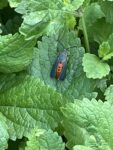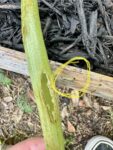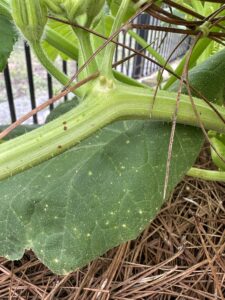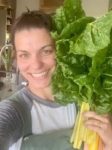The June Vegetable Garden Checklist by Paula Wolfel
June is a fun month in the garden. Although the heat starts to set in, most Austin gardeners are still reveling in gratitude for April and May’s rain. Plants are green and growing and harvest is abundant. With that said, this time of year many Austin gardeners are disappointed to find what once was a thriving squash or pumpkin plant has died. If you grow a plant in the squash or pumpkin family then you are most likely very familiar with the squash vine borer who is the most likely suspect for killing your crop.
PEST HIGHLIGHT: SQUASH VINE BORER
A Daytime Moth That Mimics a Wasp

The adult squash vine borer resembles wasps.
The squash vine borer is a common clearwing moth who flies during the day, lays eggs on the stems, vines, and leaves of summer squash, winter squash, and pumpkin plants, and whose larvae feed inside the vines and crowns of these vegetables. It is active from mid-April through June. The larvae feed inside the vine and home gardeners are often not made aware of their presence until the damage is so severe that the plant is dead. Early signs of their presence are the yellowing and wilting of leaves.

The damage to a zucchini plant from the squash vine borer larvae, which resemble maggots.
When you look at the wilting plant closely, you might notice holes near the base of the plant. These holes are filled with moist greenish or orange sawdust-like material called frass. Over time, the base may become mushy or rot away altogether.
Nearly Impossible To Control
Squash vine borers are difficult to prevent or manage. Once the larvae invade the stem, they are protected from predators and any pesticide treatments. Gardeners should check squash plants daily for the presence of adult borers. In addition to their distinct coloring, they also have a loud buzzing sound when they fly. You can squash them or trap them with a yellow container filled with water and a drop of dish soap. Check for the presence of their eggs on stems. You can pick them off with your fingernail or use tape. You can use a physical barrier and cover the plants as soon as they sprout with row covers and hand pollinate with cotton swabs or artist paintbrushes.

Squash vine borer eggs are flat, brown, and about 1/25 inch long.
If you use a physical barrier then make sure you rotate crops because squash vine borers spend the winter in the soil near their host plants. Additionally, plant vine crops that are less susceptible to squash vine borers such as butternut squash. The thicker the vine, the better chance of survival. Finally, plant a second planting of summer squash in late-July and August after the female lays her eggs.
June Vegetable Garden Checklist
Enjoy your garden before it gets really hot! Here is what should be on your June vegetable garden checklist.
FERTILIZE
- Feed vegetable plants with water-soluble fertilizer every other week as indicated by your soil test.
- Be careful to apply liquid fertilizers directly to the soil to avoid a salt build-up on the leaves.
WATER
- Water is the most important factor in the garden as the temperatures start to rise. Your plants prefer rain, but if there is none in the forecast, then make sure you are deeply watering plants
- Remember to check your soil before watering- if soil is moist 6 inches below the surface then your plants do not need to be watered. If not, adjust your irrigation schedule to water longer and more frequently.
- Irrigate in the morning so plants have time to dry before night, this helps prevent foliage diseases
- Avoid getting water on leaves by applying water to where the plant meets the soil
PLANTING
Seeds
- Cantaloupe (first part of month)
- Greens, warm season (all month)
- Okra (all month)
- Pumpkin (all month)
- Southern Peas (all month)
- Squash, Winter (first part of month)
Transplants/Slips
- Sweet Potato slips
SOIL
- Keep your soil covered with mulch to protect the surface from weed seeds blowing in and to maintain moisture below the surface.
DISEASES/PEST
- If using neem or other oil-based products, exercise care in timing applications to early morning/late evening to minimize the potential for leaf burn. Test for leaf burn in small scale trials prior to use.
- Aphids will suck plant sap from leaves, and stems. The best defense is lady bugs and they should arrive naturally. If aphids become a problem, treat with blasts of water, insecticidal soaps, or horticultural oils sprayed on the underside of leaves.
- Conchuela stink bugs (Chlorochroa ligata), Leaf-footed Bugs (Leptoglossus phyllopus), Harlequin Bugs (Murgantia histrionica), and Squash Bugs (Anasa tristis) are all a nuisance in the garden. All these bugs have piercing mouthparts that suck juices from plant leaves, stems, and fruits. They can be picked up and squashed, or thrown into a cup of soapy water. Check the bottom of leaves for eggs.
- The striped cucumber beetles (Acalymma vittatum) and spotted cucumber beetles (Diabrotica undecimpunctata) feed on blossoms of flowering plants like cucumber, squash, and melons. During the early summer they are primarily found inside flowers. They lay eggs in the soil at the base of host plants and their larvae feed on plant roots and underground parts of stems. In the late summer, the feed on foliage of cucurbit plants. Be sure to rotate your planting beds since these pests will overwinter here in the Austin area.
- Check for Mealy Bugs on tomato plants. Adult mealybugs hide and have a waxy cuticle, making contact pesticides ineffective. Insecticidal soaps, horticultural oils, and neem oil can eliminate immature mealybugs only. If using neem oil, test for phytotoxicity. As temperatures rise, oils can harm your plants. You may have better luck removing them by hand.
MAINTENANCE
- Keep the leaves of your vegetable plants off the ground to reduce rot and pest damage.
- Keep on top of weeds
HARVEST
- June is my favorite month to enjoy all the hard work you have put into the garden to date. Depending on when you got seeds or transplants in the ground, you could be harvesting a little of almost everything this month: zucchini, summer squash, winter squash, tomatoes, peppers, eggplant, cucumbers, green beans and snap peas, watermelon and cantaloupe.
Additional Resources
Weather Strategies for Austin Gardens
Watch the Vegetable Gardening in Central Texas Webinar
Vegetable Planting Calendar (Español, 繁体中文)
Recommended Vegetable Varieties for Travis County
Easy Gardening Series Detailed tips from Texas A&M University AgriLife Extension on specific crops and practices.
Vegetable Gardening in Austin Resource hub for all things vegetables for Travis County
Plant Rotations, Successions and Intercropping
Monthly Gardening Calendar for Austin and Central Texas
Sustainable Food Center Farmers Markets
About Paula Wolfel
 Paula Wolfel joined the Travis County Master Gardener program in 2022 and has taken extra training to become a vegetable specialist. She grew up in the suburbs of Chicago learning how to garden from both her father—a Sicilian vegetable and fruit tree gardener—and both her grandmothers, and then spent years in Virginia gardening. Paula loves gardening because she finds it to be a grounding force- it gets her out of her head and into the present. She loves the pride that comes with cooking a meal for her family with every ingredient coming from her garden… and then the humility she feels when she loses an entire crop because of Mother Nature. She finds gardening to be wisdom, lessons, best practices passed down generation to generation, season to season and hopes to share that with you.
Paula Wolfel joined the Travis County Master Gardener program in 2022 and has taken extra training to become a vegetable specialist. She grew up in the suburbs of Chicago learning how to garden from both her father—a Sicilian vegetable and fruit tree gardener—and both her grandmothers, and then spent years in Virginia gardening. Paula loves gardening because she finds it to be a grounding force- it gets her out of her head and into the present. She loves the pride that comes with cooking a meal for her family with every ingredient coming from her garden… and then the humility she feels when she loses an entire crop because of Mother Nature. She finds gardening to be wisdom, lessons, best practices passed down generation to generation, season to season and hopes to share that with you.

